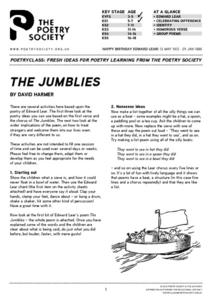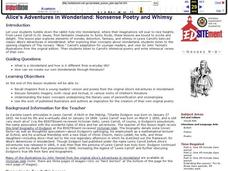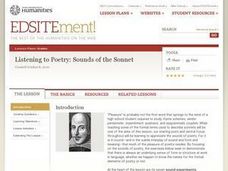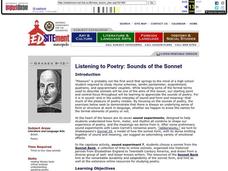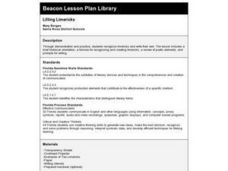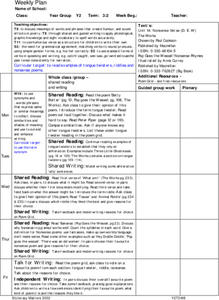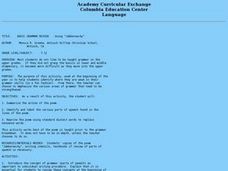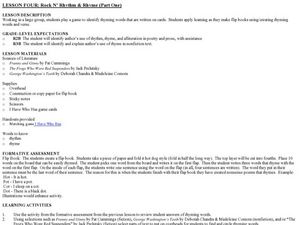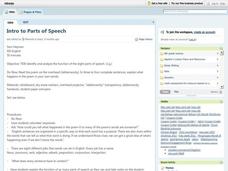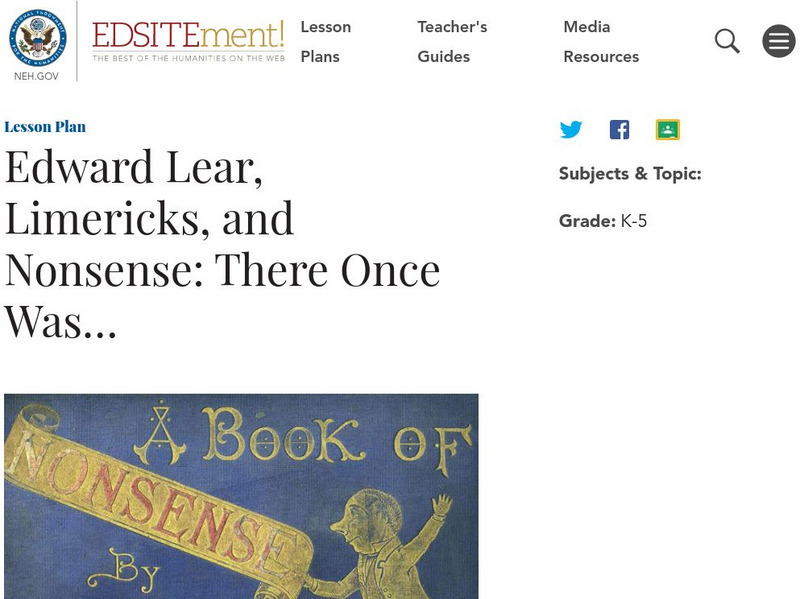Curated OER
Edward Lear, Limericks, and Nonsense
Introduce your class to the delights of nonsense poetry and explore literary devices with the writing of Edward Lear. Learners identify rhyme and meter as well as figures of speech, alliteration, and onomatopoeia in "The Owl and the...
Curated OER
Short Poems Are Scary!
What do all those chairs and pencils do in the classroom once everyone leaves? Allow imaginations to run wild with frighteningly short poems!
Curated OER
Edward Lear, Limericks, and Nonsense: There Once Was...
Students recognize poetic devices including rhyme, syllabification, and meter. They identify the characteristics of a nonsense poem and of a limerick. They write their own limericks.
Poetry Society
The Jumblies
Who would ever think to go to sea in a sieve? Only Edward Lear's Jumblies! The poem "The Jumblies" is the inspiration for these poetry reading and writing activities that ask learners to think about how strangers are different, consider...
Curated OER
Alice's Adventures in Wonderland: Nonsense Poetry and Whimsy
Primary learners are introduced to Lewis Carroll's whimsical poetry. They read "The Nursery Alice" Carroll's adaptation for younger readers, view story illustrations, listen to poetry and write whimsical verses of their own about food.
Curated OER
Edward Lear, Limericks, and Nonsense: There Once Was?
Students explore limericks. In this poetry writing lesson, students listen to and read a variety of poems written by Edward Lear. Students count syllables and identify meter by clapping as they read aloud. Students complete a limerick...
Curated OER
Listening to Poetry: Sounds of the Sonnet
Students investigate how sound influences meaning in poetry by listening to sonnets. They write an analysis after listening to and reading sonnets.
Curated OER
Nonsense Knows
In this poetry lesson, young readers discuss that poems can sometimes have silly words and made up people, places, and things. Learners read and listen to silly poems then write a response poem to their favorite.
Bright Hub Education
Jabberwocky - A Creative Writing Lesson Plan
Make some sense out of Lewis Carroll's famous nonsense poem "Jabberwocky." After reading through the poem, introduce the word portmanteau and send small groups off to alter the original poem.
Curated OER
Listening to Poetry: Sounds of the Sonnet
Young scholars experience and enjoy the sounds of poetry. They erform sound experiments with sonnets and closely read and analyze a sonnet by Shakespeare. Students write an analysis of how sound affects meaning in a sonnet chosen from...
Curated OER
"Jabberwocky": Inferring
Pupils, over an extended time, read and explain the nonsense words of Lewis Carroll's poem, "Jabberwocky". They infer the meaning of the poem using visualizing as well as decoding skills. While written for first graders, this is easily...
Curated OER
"Quack Said the Billy-goat"
Second graders read the poem together, "Quack Said the Billy-goat" and discuss what makes the poem funny and which words rhyme. They observe the teacher writing a new first verse, changing some of the text, but leaving the original rhyme...
Curated OER
Lilting Limericks
Students discover the formula for writing limericks and use it to write their own poems.
Curated OER
Jabberwocky Lesson Plan
Students complete a review of the parts of speech using a jabberwocky poem format. In this parts of speech and poetry lesson, students read a jabberwocky poem and identify parts of speech in the poem. Students list adjectives, verbs, and...
Pearson
Rumpelstiltskin
Classic fairy tales are great! They have memorable characters, present interesting story lines, and lend themselves to art projects. Grab a copy of "Rumpelstiltskin" and get ready to participate in several early literacy activities. The...
Curated OER
Tongue Twisters
Second graders read the poem, "Betty Botter" and give their opinion of it. They discover what a tongue twister is and read the poem out loud together. Then as a class they read "Peter Piper" and discuss the similarities of the two poems.
Curated OER
Listening for Tone
Students read and listen to various poems as they are read by different readers using different tones. They read "Jabberwocky" and in groups, determine what they think the nonsense words in the poem mean. The groups compare thier ideas...
Curated OER
BASIC GRAMMAR REVIEW Using "Jabberwocky"
Students use the poem Jabberwocky to discover where they are weak in grammar. They rewrite the poem using standard dialect words instead of nonsense words.
Curated OER
Language: Has the Cat Got Your Tongue?
Use funny tongue twisters to entice your young learners! They'll love this game where they face off against members of the other team and recite tongue twisters. Who will win this enunciation and pronunciation competition!
Curated OER
Where Do We Begin?
Primary learners grasp sequence of events by discussing morning routines and reviewing the story of Little Red Riding Hood. They explore the necessity of correct order of events. As a class, create a story with a beginning, middle, and...
Curated OER
Rock N Rhythm & Rhyme (Part One)
Young scholars make flip books of rhyming words and match words together that are on cards. In this rhyming lesson plan, students read books and read individual words to identify rhyming words.
Curated OER
Intro to Parts of Speech
Students define eight parts of speech, classify words as specific parts of speech, describe their function, and explain how parts of speech help us to communicate more clearly.
Curated OER
Rhythm and Rhyming Long Rope Jumping
Students discuss the importance of rhythm in rope jumping. They practice turning, then jumping. Students discuss the various types of rhymes. They work in groups for a couple of classes, students rotate from chart to chart trying out...
National Endowment for the Humanities
Neh: Edsit Ement: There Once Was...
Part 2 of this tutorial on limerick writing demonstrates the importance of form (meter and rhyme) in limerick poetry using the exemplary and amusing work of Edward Lear.





